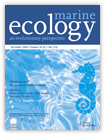Rejection of Intracoelomic Invading Material by Leptosynapta inhaerens (Echinodermata: Holothuroida): A Process of Ecological Significance?
Abstract
Abstract. The synaptid holothuroid Leptosynapta inhaerens has the ability to expel unwanted particles that enter its body cavity. Intracoelomic particles (viz. experimentally injected carmine particles) are trapped either by a coelom-produced mucoid net or by specialized organs (the vibratile urnae) that occur in bands in some interradial areas. Whatever the trapping method, particles are incorporated into dense mucoid masses that move towards the posterior part of the body cavity, in the vicinity of the rectum. These aggregates then cross the rectal wall through rectal pores, mix with the faeces, and are eventually incorporated into the wall of the synaptid burrow. Clearance of foreign particles requires 2 to 3 days. The coelom-cleaning system of synaptids appears to be the most effective within the class Holothuroidea, being well designed for endofaunal organisms whose walls are delicate and easily rupture.




